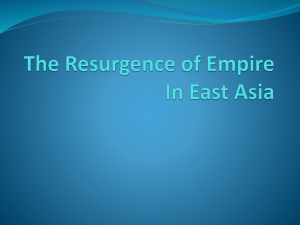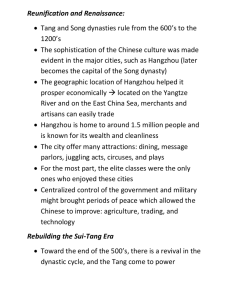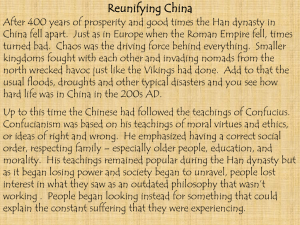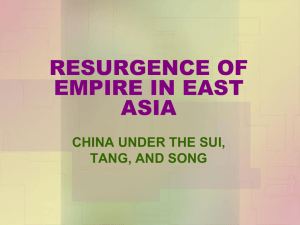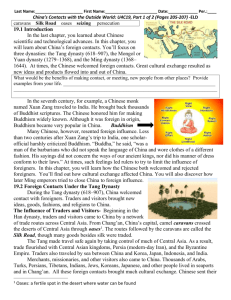Ch. 14 Notes
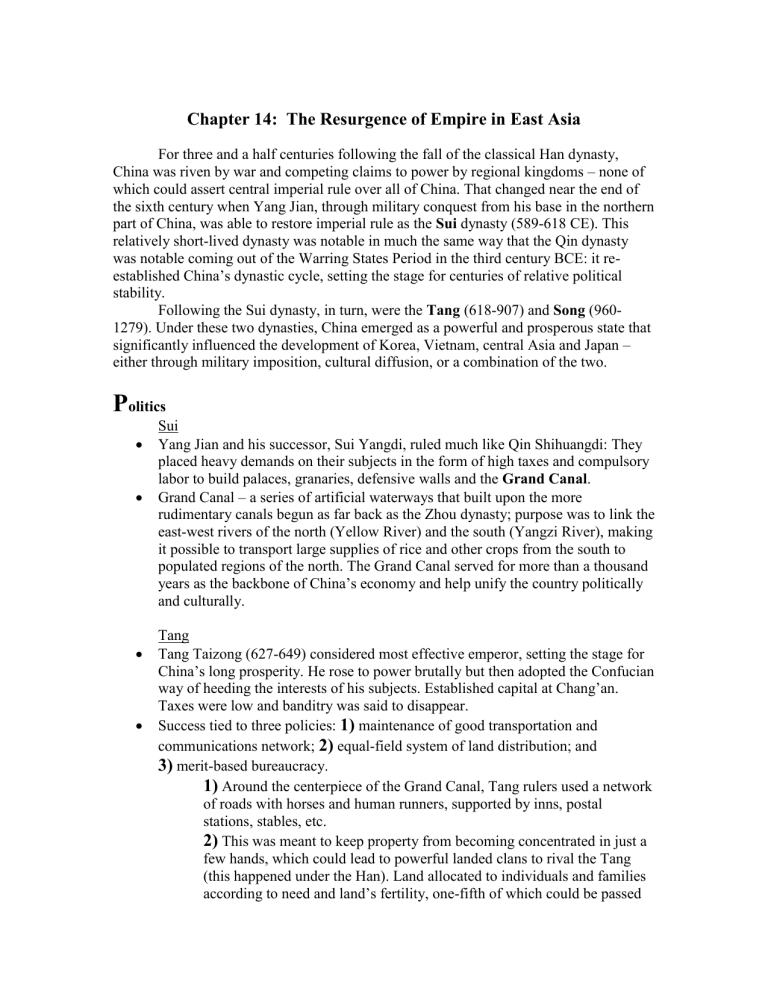
Chapter 14: The Resurgence of Empire in East Asia
For three and a half centuries following the fall of the classical Han dynasty,
China was riven by war and competing claims to power by regional kingdoms – none of which could assert central imperial rule over all of China. That changed near the end of the sixth century when Yang Jian, through military conquest from his base in the northern part of China, was able to restore imperial rule as the Sui dynasty (589-618 CE). This relatively short-lived dynasty was notable in much the same way that the Qin dynasty was notable coming out of the Warring States Period in the third century BCE: it reestablished China’s dynastic cycle, setting the stage for centuries of relative political stability.
Following the Sui dynasty, in turn, were the Tang (618-907) and Song (960-
1279). Under these two dynasties, China emerged as a powerful and prosperous state that significantly influenced the development of Korea, Vietnam, central Asia and Japan – either through military imposition, cultural diffusion, or a combination of the two.
P olitics
Sui
Yang Jian and his successor, Sui Yangdi, ruled much like Qin Shihuangdi: They placed heavy demands on their subjects in the form of high taxes and compulsory labor to build palaces, granaries, defensive walls and the Grand Canal .
Grand Canal – a series of artificial waterways that built upon the more rudimentary canals begun as far back as the Zhou dynasty; purpose was to link the east-west rivers of the north (Yellow River) and the south (Yangzi River), making it possible to transport large supplies of rice and other crops from the south to populated regions of the north. The Grand Canal served for more than a thousand years as the backbone of China’s economy and help unify the country politically and culturally.
Tang
Tang Taizong (627-649) considered most effective emperor, setting the stage for
China’s long prosperity. He rose to power brutally but then adopted the Confucian way of heeding the interests of his subjects. Established capital at Chang’an.
Taxes were low and banditry was said to disappear.
Success tied to three policies:
1)
maintenance of good transportation and communications network;
2)
equal-field system of land distribution; and
3)
merit-based bureaucracy.
1)
Around the centerpiece of the Grand Canal, Tang rulers used a network of roads with horses and human runners, supported by inns, postal stations, stables, etc.
2)
This was meant to keep property from becoming concentrated in just a few hands, which could lead to powerful landed clans to rival the Tang
(this happened under the Han). Land allocated to individuals and families according to need and land’s fertility, one-fifth of which could be passed
down as a hereditary possession and the rest redistributed later. In later years, the system began to weaken as people found ways around the redistribution plan, rising population placed additional pressures on the land, and Buddhist monasteries took up increasing amounts of land.
3)
Tang rulers continued and built upon this policy, following example of the Han. Produced a talented class of intellectually capable bureaucrats to administer the affairs of state and remain loyal to the ruling family.
Used military to extend its influence into Manchuria in the north and conquer northern part of Vietnam. Forced the Silla kingdom in Korea to acknowledge the
Tang emperor as overlord. Authority imposed westward to the Aral Sea, including part of Tibet.
Tributary relationships with subordinate states – Again following the Han, Tang rulers of China (the “Middle Kingdom”) would receive envoys from subordinate states, who would bring tokens and gifts and perform the kowtow for the emperor
… who would in turn receive confirmation of their authority and be given lavish gifts. Mainly symbolic: Chinese authorities in truth often had little control over subordinate lands, but the ritual of the tributary system fostered trade, cultural exchange and diplomacy.
Decline and fall – The Tang dynasty weakened after a neglectful emperor allowed rebellious military commander An Lushan to capture the capital at Chang’an.
Tang commanders turned to outside military help from the Turkish Uighurs, who then demanded the right to sack the capital after expelling the rebels. The Tang lost all control after this crisis, and – as the equal-field system was already weakening, leading to popular discontent over land being concentrated into fewer and fewer wealthy hands – their decision to give more power to regional military commanders backfired … because those commanders, or warlords, then became the effective rulers of China.
Song
Warlords ruled China from the Tang’s fall in 907 until the Song dynasty was established in 960.
In contrast to the Tang, Song rulers did not establish a strong military state, focusing more on civil administration, industry, education and the arts.
Greatly expanded the merit-based bureaucracy by providing more opportunities for individuals seeking Confucian education and civil service exams. Paid these individuals well and even placed some in charge of military forces.
Huge bureaucracy put a huge burden on the treasury, however, and efforts to raise taxes angered peasants.
Lack of military emphasis also spelled trouble: nomadic incursions became numerous along China’s northern border. Song China eventually shrank to the south and finally fell to Mongol forces in 1279.
E conomics
Agriculture
When Sui and Tang armies imposed control over southern China and invaded
Vietnam, they encountered ways to greatly boost agricultural production, which fueled a) population growth (45 million to 115 million between 600 and 1200), b) urbanization
(Tang capital of Chang’an was world’s most populous city at around 2 million inhabitants, and dozens of cities had more than a hundred thousand people) and c) economic development . In Vietnam, they found new strains of fast-ripening rice capable of producing not one but two crops per year. Also, new agricultural techniques:
1.
better use of heavy iron plows, harnessed to oxen and water buffaloes.
2.
extensive use of manure and compost.
3.
elaborate irrigation systems (reservoirs, dams, canals), including pumps and water wheels powered by man and animal … all of which allowed them to cultivate previously useless land (e.g., mountainsides, by terracing).
Industry
With abundant food, Chinese craftsmen could innovate: developed a lighter, thinner, higher-quality porcelain (fine porcelain became known as chinaware
) … a technique that diffused to other societies as China exported huge amounts of these products.
Iron and steel production also skyrocketed (tenfold increase in iron production from early 9th to early 12th centuries).
Market Economy
Trade grew remarkably under the Tang and Song as domestic and export demand for silk, porcelain and other goods increased. Government policies (maintaining good transportation systems, distributing staple foods, monitoring the iron industry) also helped integrate China’s economy.
A shortage of copper coins led Tang merchants to begin using “flying cash,” or letters of credit. Other financial instruments: promissory notes and checks. Paper money was then invented as another alternative to cash. Merchants pioneered its use, but later the government began issuing it. Paper money was a vital stimulus to the economy, but for centuries it experienced problems with counterfeiting, oversupply, lack of creditor confidence, etc.
The Tang and Song economic juggernaut – with imports and exports coming and going by land and sea – produced Chinese consumers eager for exotic imported goods, and it brought to China a cosmopolitan mix of foreigners (Persian entertainers and
Persian, Arab, Malay and Indian mariners and merchants in southern Chinese port cities).
C ulture
Patriarchal Social Structure
A much greater emphasis was placed on the Chinese tradition of venerating family ancestors during the Song dynasty, and the patriarchal nature of the family became
more strict. Extended families would travel long distances for annual rituals honoring deceased ancestors, which strengthened family cohesiveness. But women – especially those from the privileged classes – became subject to the popular practice of foot binding
, the tight wrapping of young girls’ feet with strips of cloth that prevented natural growth and led to tiny, deformed feet. Eventually many of these women needed to walk with a cane or be carried around by servants. Similar to veiling of women in the Islamic world: women were placed under the tight supervision of husbands or male guardians.
Buddhism
Buddhist merchants brought their religion from India to China via the Silk Roads as early the second century BCE. Over time, and especially during the Tang and Song eras, Buddhism found a more popular following as western oases sites became home to hundreds of cave temples with elaborate murals, libraries of Buddhist texts, and missions seeking converts. Eventually, monasteries appeared in all major cities and stupas popped up all over the Chinese landscape. Buddhism attracted Chinese interest because of its high standards of morality, intellectual sophistication and promise of salvation … but eventually some Chinese began to object: They a) saw the Buddhist commitment to celibacy and the monastic lifestyle as a threat to traditional Chinese emphasis on the family; b) considered Buddhist monasteries harmful to the economy because they were exempt from taxation; and c) scorned Buddhism as inferior because of its foreign origins.
So Buddhism became increasingly interpreted in light of some of these Chinese objections. Missionaries tailored their message in light of Daoism and a syncretic faith emerged: Buddhism mixed with Chinese characteristics. Despite this, Daoist and
Confucian critics maintained their hostility and eventually convinced Tang emperors to persecute Buddhists (as well as those practicing other foreign faiths) by closing down monasteries and expelling Buddhists from the country. This persecution was only partial, however, and the Buddhist influence remained and even influenced Confucianism during the Song era
Neo-Confucianism : a philosophy that attempted to merge the basic practical and personal behavior elements of Confucianism with the more abstract and metaphysical characteristics of Buddhism.
Chinese Influence in East Asia
Neo-Confucianism was among the most important Chinese cultural influences on surrounding lands – most notably Korea, Vietnam and Japan. Despite periodic invasions of Korea and Vietnam, China did not absorb these countries. They all remained distinctive in their own right, but they participated in the tributary system and engaged the Chinese in trade, thereby reflecting the larger East Asian society centered around
China. To varying extent, such cultural elements as art, literature and architecture were shaped by China in the wider East Asian context, and the writing systems of Korea,
Vietnam and Japan were all based at least somewhat on Chinese ideograms.
Korea, more so than China, was dominated by aristocrats and royal houses, and it never established a merit-based bureaucracy. The Viets were less cordial in their tributary dealings with China. They mounted a series of revolts against the Tang and eventually won their independence even as they continued to absorb Chinese cultural influence.
Many Vietnamese preferred and remained loyal to their own religions, though Buddhism
did win a large following. Vietnamese women enjoyed a more prominent role in the economy and society. In contrast to Korea, Vietnam did institute a Chinese-inspired bureaucracy.
China never successfully invaded Japan. Prior to the central rule of the Sui and
Tang dynasties in neighboring China, Japan was ruled by dozens of small, regional states.
Then in the 8th century, inspired by the Tang example, one of the Japanese aristocratic clans claimed imperial authority and set upon modeling Japanese society after China
(e.g., centralized politics with a bureaucracy, established an equal-field system). Japan retained its distinctiveness while copying China in many ways: It adopted Confucian and
Buddhist traditions but retained its native Shinto religion, which focused on the worship of ancestors and belief that divine spirits dwell in nature (i.e., an especially beautiful tree, rock, waterfall or mountain was considered the home of a kami , or divine spirit).
Heian Japan (794-1185) – In 794, the emperor of Japan transferred his court from Nara to Heian, which is modern Kyoto, and this became the seat to a society that drew inspiration from China but maintained distinct Japanese traditions. Heian court life is reflected in the literary work The Tale of Genji , which tells of the experiences of a fictitious imperial prince named Genji, who lives amid gardens and palaces and devotes himself to an ultra-refined lifestyle. But as he and his friends age, they become melancholy as they reflect on their irrecoverable youth
Unlike in China, Japanese emperors served as figureheads – symbols of power, behind whom lay the real authority, initially an aristocratic clan known as the Fujiwara family. Since the ninth century, Japan almost continuously maintained this dichotomy of publicly recognized authority on the one hand (the emperors), and the separate agent of effective rule on the other (the power behind the throne). Thus the imperial throne, not susceptible to deposition, has withstood periodic times of trouble. Heian Japan fell as the equal-field system waned and aristocratic clans accumulated most of the Japanese islands’ lands into vast estates. Two of these clans clashed, and the winner installed its clan leader as shogun – a military governor who ruled in place of the emperor. This clan dominated political life in Japan for most of the next 400 years.
Chinese influences were somewhat suppressed during the medieval period – which came between the Heian period and the Tokugawa dynasty that emerged in the sixteenth century. Medieval Japan was characterized by decentralized rule, where provincial lords wielded power in local regions where they controlled land and economic affairs. As they competed with one another, they found little use for Chinese-style bureaucracy or the refined court life of earlier rulers. Military discipline came to be valued above all else, and the samurai, or mounted warrior, played a key role in Japanese political and military affairs as they served the provincial lords.
S cience and Technology
Porcelain
During the Tang era, Chinese craft workers developed techniques for producing high-quality pottery that was lighter, thinner and more refined than earlier products.
Porcelain, fired with glazes, became as much works of art as eating utensils. While these techniques diffused to craftsmen elsewhere (to the Abbsid realm in particular), demand
for Chinese porcelain was so strong across Eurasia and the port cities of east Africa that fine porcelain came to be known as chinaware (hence, your grandmother’s prized china cabinet).
Metallurgy
Tang and Song craftsmen produced stronger and more useful metals when they discovered they could burn coke instead of coal in their furnaces. Iron production increased tenfold from the early ninth to the early twelfth centuries. These techniques also found their way outside of China.
Gunpowder
One of the more consequential inventions ever, gunpowder was invented accidentally (and ironically) during the Tang dynasty by Daoist alchemists looking for a concoction that might prolong life. When you mix charcoal, saltpeter, sulphur and arsenic you tend not to prolong life – you can, in fact, end it pretty abruptly. This technology of gunpowder led to primitive flamethrowers by the tenth century and rudimentary bombs by the eleventh century, and by the thirteenth century the technology was spreading to southwest Asia and then Europe, where metal-barreled cannons were soon in operation.
Printing
Another of history’s extraordinarily important inventions, printing became common during the Tang era (though some form of printing may have predated the Sui dynasty). Printers, by the mid-eleventh century, had moved from block-printing techniques to movable type … but because formal writing in Chinese involved tens of thousands of different characters, printers found movable type too impractical. Europeans would later take both paper and movable type from the Chinese to fashion the first printing presses. Still, by the late ninth century the Chinese were producing many
Buddhist texts, Confucian works, calendars, agricultural treatises and popular works.
Naval technology
Chinese seafarers made a number of improvements to ships and sailing: iron nails, waterproofing, watertight bulkheads, canvas and bamboo sails … and, most important, the magnetic compass with its “south-pointing needle.” The compass figured prominently in expanded trade and expedition throughout the India Ocean basin.


